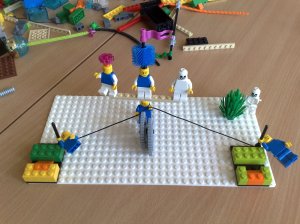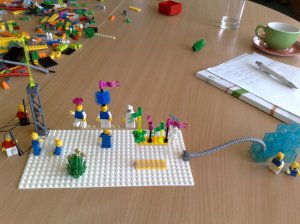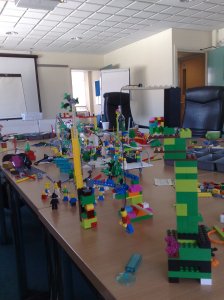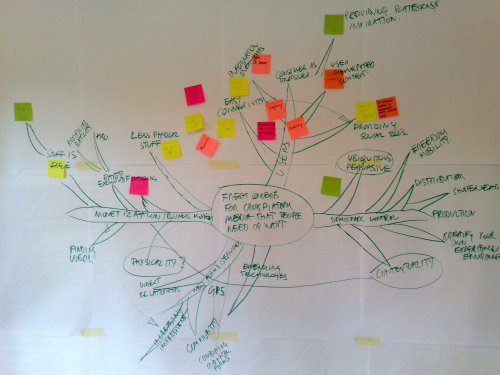The BBC camp? Never. This was BeeBCamp.
Today I attended a really interesting event (‘unconference‘) with various other ‘digital types’ from around the BBC to discuss, well anything we wanted. I attended a number of self-organising sessions, and here’s some of my notes and thoughts:
Session 1: The BBC’s first MMOG (massively multiplayer online game)
This session was run by Dave Anderson from BBC Worldwide (the commercial arm of the BBC) and he talked about a MMOG called Tronji that they’ve co-developed with BBC Children’s. It was very interesting to learn about how this has been developed as its getting close to going into beta about how they’re hoping to build critical mass.
The big challenge for Dave seemd to be reconciling how his part of the BBC could find a business model and tech to support it that would allow them to commercialise the world they’ve built for non-UK users while making sure that license fee payers get a great free experience. He’s not the only one thinking about this. It’s come up in a number of projects I’ve worked on over the years and is always tricky and is a particularly live issue on one of the projects I’m working on now.
IP detection seems to work to an extent for us – but it’s not perfect and is far less perfect on mobile than it is for fixed-line broadband. Issues like Opera Mini routing all its users through Norway and Blackberry using strange international proxy servers means that determining which country a mobile user is in is far more complicated than it is for a fixed-line broadband user. I guess by the very nature of mobiles being, er, mobile, they’re harder to track. There’s also the issue of what happens when a user with a UK sim card and subscription roams out of the UK and the issues of when a non-UK user roams into the UK. (Nevermind my friend who’s phone picked up Orange France while he was standing in Dover recently…)
Session 2: What is the Common Platform?
Steve Bowbrick (who it turns out I worked with on a project called TotalTele.com way back in 1997 and haven’t seen since) is the BBC’s new ‘Blogger in Residence’ – but he’s not just blogging. He’s advocating something he calls (somewhat clunkily in my humble opinion) the Common Platform. He described himself as being a ‘critical friend’ – one who can be friends with everyone around but who won’t go native while he’s here – I liked this way of describing what he’s doing.
So what is it?
It seems to be a vision he’s creating for what the BBC could be and how it could provide value after the ‘broadcast era’ that’s centred around ‘openness.’ He said it should involve 5 things: Creation, Enterprise, Learning, Participation and Communication. I can’t argue the BBC shouldn’t do those things but, I want to know more about what he’s got in mind – I’m sure alot of other people in the room have had those thoughts.
When pushed on the details of how exactly he imagined his vision manifesting itself, Steve elaborated that he thought it was like an ‘added layer’ on top of what’s already there on the Internet. Interesting, but some would argue the Internet already exists and no one needs the BBC trying to control it and that as an organic network it will improve itself to meet the needs of its users. I pressed him about whether he thinks the layer is something that the BBC should build or if its something that we can encourage the growth of by building our stuff in certain ways and he didn’t seem convinced either way. Personally, I think there’s a greater case for building public value (did I just use that phrase?!) by building things well and setting examples that will build up better semantic relationships rather than trying to create some monster application that will try to ‘control’ a medium that clearly isn’t controllable. Granted, the control Steve is talking about is enhancements that make it all better but I can’t help but be wary.
Session 3: How NOT to run an Alternate Reality Game
This session was really interesting – I didn’t even know the BBC had attempted an ARG before today – but it also annoyed me. The speakers told us about how they had run an ARG around the programme Torchwood and about the lessons they learned. They were (not direct quotes):
- Don’t make any assumptions about your reality or the alternate one you’re creating – check everything;
- Don’t underestimate how much work it will take;
- Be prepared for there to be a change in the real world (say current events) that require you to change your alternate reality.
All very sensible from what I could see – and great to get these tips ‘from the horses mouth.’
That said, the speaker didn’t feel the work had been worth the effort (despite others in the conversation being fairly impressed with the stats!) and seemed to be advocating that the BBC not try an ARG again. (He did suggest that we might do less elaborate “brand extensions” so wasn’t completely negative on the idea.)
Now, from my perspective, not getting something QUITE right doesn’t mean never do it again. It certainly didn’t sound like a failure and I’d rather see us try to do better next time.
The game, as it was described to me, ran exactly alongside episodes – so was in some ways still essentially linear and only had the length of the series to attract an audience from TV. I’d like to see one where the story is less linear and that can last over a longer period of time to catch on virally. The game also sounded very PC-based (though there were clearly links into the real world) and I’d like to experiment more with what we can do with mobile and out-of-home content to see if we can create ARGs that manifest in the real world away from the PC. I think there’s a connection to be made with geocaching here too… somehow.
I’d love to know about any great examples of mobile ARGs that people have seen!
Session 4: Does the BBC need a games strategy?
Really interesting conversation here. The general consensus here was that yes, we do need one. The audience are crying out for them and will abandon us if we don’t engage with gaming. But, more interestingly, we discussed the fact that even amongst the people around the table, everyone was talking about something different when they talked about a ‘game’. Console games, mobile games, virtual world games, ARGs, playground games, board games, web-based games, puzzles, the list goes on. It wasn’t until the end of the conversation when I mentioned Celebdaq that anyone really discussed the fact that this is probably the most successful game the BBC has done to date.
I think a great outcome of this would be for someone to put the type of games into some sort of simple framework and then say what our business strategy for each type is. One serious fly in the ointment was the that the BBC is in a tricky space from a regulatory perspective when it comes to games but, interestingly, the ways of working in this space that we talked about almost all included collaboration with the games (or other) industries, which I think show how we could create beneficial partnerships across the range of games and I think that if this was mapped against the framework for the types of games we could produce it could be a powerful way forward in a space that’s traditionally been very difficult.
There’s probably already a bright spark someplace in the BBC that’s already done this so if you’re out there, please, come out, come out wherever you are…
Which reminds me – if nothing else – today was a great day for meeting and connecting with alot of smart folk from around the business I work in. The type of day that makes me really happy to work for the Beeb.
Session 4: My session! – Should We Bother With Bluetooth?
I lead a conversation with a few other people about whether or not we should try to use Bluetooth as a distribution mechanism. The conversation basically centred around the fact that Bluetooth is widely used by teens and a free technology which makes it even more attractive to them. In fact, one report I read said that UK teens and young people use Bluetooth more than their peers in any other country. All that said, when we’ve tried to do projects using Bluecasting, the results have been underwhelming.
Bluecasting and users Bluetoothing content to each other are clearly two different ways of communicating and what I took away from the session is that we should move our Bluetooth efforts towards trying to fit with the natural behaviour that teens have – sending stuff between themselves – rather than trying to be a, errrr, broadcaster pushing content over-the-air to them in a linear fashion (Bluecasting). We talked about trying to create a non-linear narrative that was distributed this way and how you might be able to use it in conjunction with a ‘hidden camera’ or game show… If anyone has any ideas, please shout!
A few thoughts on how the day was shaped
It was great that people took the time out to organise the day and, as I said above, it was a really good one that made me happy to be working at the BBC. But I thought I’d share a few thoughts on the format since creative facilitation is one of my interests.
The day was billed as an ‘unconference’ that was self organising. The ‘un organisers’ put a grid of times and tables on the board and asked people to talk about something or pose a question for people to join them to talk about. It reminded me of the ‘Open Space’ methodology which I’ve seen used other places with slightly different executions.
Open Space aims to be light touch and when you have a bunch of like-minded and engaged people in a room works well but, there’s a few things that still could have gone better:
Ground rules. You gotta have em. I know that no one likes them and thinks they know them, but there were a few times today when I thought it would have been good to remind people that in this type of setting ‘no idea is a bad idea’, etc. We were told ‘No Powerpoint’ upfront – which was a godsend. I also felt like it would have been helpful to have a few neutral facilitators around to help slow conversations build up momentum – or even just some pointers about unconference techniques that work well, for people who felt ‘stuck’ during their conversations.
Also, moving on from these types of events is always hard. We talked about this a little bit at the end, but a mechanism to help people try to take something concrete away might have strengthened it. In any training on how to run these types of things, one of the thing you learn is that you should ‘record everything’ and I really agree with that. Lots of people were making notes today – and I’m sure I’m not the only one blogging by any stretch of the imagination – but I still feel like some great stuff might get lost – purely because there was just SO much good stuff!






